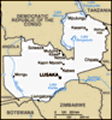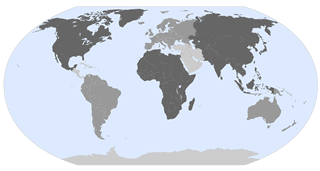Advertisement
Published: September 24th 2012
Livingstone – 18 – 21 August 2012: is to Zambia what the town of Victoria Falls is to Zimbabwe. Also known as Maramba, it was once the capital of Zambia before it was moved to Lusaka. Livingstone is in the Southern Province of Zambia. We arrived at 1.00pm. It was our plan to arrive as early as possible as there were 4 people leaving the tour, so this gave them 1 ½ days to look around and be involved in some of the activities associated with the Falls.....and there was plenty to do – helicopter and ultra light plane rides over the falls, bungy jumping, flying fox rides and swings, canoeing, white-water rafting, game and rino walks, elephant back rides etc etc. and of course not forgetting to actually walk around the Falls. What did we do – as we have done almost everything in other parts of the world, several times (except bungy jumping and that is not on my ‘To Do’ list), we walked around the mighty Falls and THE BEST THING was the Ultras-Light Plane over the falls. FANTASTIC – more on that later.
The falls are on the border between Zimbabwe
and Zambia.
Livingstone is a historic colonial city, a tourism centre for the Victoria Falls lying 10 km north of the Zambizi River, and a border town with road and rail connections to Zimbabwe on the other side of the Falls. Its population was estimated at 137K inhabitants. It is named after David Livingstone, the British explorer who was the first white man to explore the area.
In the 1890s Cecil Rodes’ British South African Company established imperial rule north of the Zambezi and launched a wave of mineral prospecting and exploitation of other natural resources such as timber, ivory and animal skins in the territory it called North-Western Rhodesia. The main crossing point of the Zambezi was above the falls at the Old Drift, by dugout canoe, later an iron boat propelled by eight Lozi paddlers, or a barge towed across with a steel cable. The Batoka Gorge and the deep valley and gorges of the middle Zambezi (now flooded by the Kariba Dam) meant there was no better crossing point between the Falls and Kariba Gorge, 500 km) north-east. As the Old Drift crossing
became more used, a settlement sprang up there and around 1897 it became the first municipality in the country and is sometimes referred to as 'Old Livingstone'. Proximity to mosquito breeding areas caused deaths from malaria, so after 1900 the Europeans moved to higher ground known as Constitution Hill or Sandbelt Post Office, and as that area grew into a town it was named Livingstone in honour of the explorer.
In the mid 1890s Rhodesian Railways had reached Bulawayo in Southern Rhodesia spurring industrial development there, fuelled by the coal mines at Hwange just 110 km south-east of Mosi-oa-Tunya. The railway was extended to Hwange for the coal, but Rhodes' vision was to keep pushing north to extend the British Empire, and he would have built it to Cairo if he could. In 1904 the railway reached the Falls on the southern side and construction of the Victoria Falls Bridge started. Too impatient to wait for its completion, Rhodes had the line from Livingstone to Kalomo built and operations started some months in advance of the bridge using a single locomotive which was conveyed in pieces by temporary cableway across the gorge next
to the bridge building site.
With the new Bridge open in September 1905, Livingstone boomed and the British South African Company moved the capital of the territory there in 1907.
Of all the towns in Northern Rhodesia, colonial Livingstone took on a character most like those of Southern Rhodesia or South Africa at that time, with a strongly marked segregation which while not being officially enshrined as an apatheid policy, had similar practical effects. The north and western halves of the town and the town centre were reserved for the colonial government and white-owned businesses and associated residential areas, while African townships such as Maramba (named after the small Maramba River flowing nearby) were in the east and south. Asians and people of mixed race owned businesses in the middle, on the eastern side of the centre.
As independence approached and for a few years after, many whites in the town moved to Rhodesia or South Africa.
At independence, Livingstone had the benefit of some spending by the new government on development.
This included a vehicle assembly plant, as well as the benefit of tourism by the army of expatriates hired to assist those projects, as well as by Zambians experiencing for the first time the pride and freedom of their own country. However, from the late 1960s, when the Rhodesian UDI crisis forced Zambia to close the border at Livingstone, the town suffered economic decline due to a fall in tourism and the loss of trade to the south. In the 1970s and 80s this was exacerbated by national economic woes brought on by low copper prices and the failure of the government's economic management, so that when trade to the south re-started with Zimbabwean independence in 1980, Livingstone could not take advantage of it. The town seemed stuck in a time warp and was unable to afford new development or maintain the existing infrastructure. Although this meant that historic colonial buildings were not replaced by new development, it also meant the town could not afford to adequately preserve those that it had.
In the last ten years, although manufacturing industry has continued to decline with the closure of textile businesses unable to compete
with Asian imports. With the demise of Zimbabwe, Livingstone has experienced resurgence in tourism and has firmly become the destination of choice when visiting the Victoria Falls. Livingstone has enjoyed a influx of investment in the industry from modern and sophisticated hotel chains like Sun International, to modern shopping centers and restaurants.
Victoria Falls, a UNESCO World Heritage Site, is one of the most amazing sights in the world. Twice as tall as Niagra Falls, and several times longer, Victoria Falls affords visitors a once-in-a-lifetime sightseeing experience. It might not be the very biggest, but few will debate that it's the most spectacular. The Victoria Falls is the largest curtain of falling water in the world.
Thanks to a well-designed park, we could touch the waters of the Zambezi just meters before it plunged over the falls; cross the gorge on a narrow bridge that provides spectacular views; and take thousands of photos - without a single one being redundant.
Wet weather gear is for hire as you enter the park, however we didn’t need it as the water
level going over the falls is less in the dry season. This is a real advantage as you can actually see the Falls but on the other hand, in the wet season (April – June) the water is apparently thundering over. When you turn left after walking through the entry gate, you walk in front of the gorge and see the water. When we took the track to the right we saw the water just before it drops. This is called the cascades. When we stood just before the water fell over the falls, there were fantastic photo opportunities with a permanent rainbow from the mist of the falls.
We then walked onto Livingstone Island, walking over the newish bridge. Livingstone Island is situated in the Zambezi River, 2 or 3 feet from the top of the Victoria Falls on the Zambian side.
There is also a 600 metre walk down some steep steps to see the Devil's Pool. After all the water falls over the wide drop, it all flows through a narrow ravine and on the other side, creates amazing rapids and water washes.
We saw many canoeists having fun going from 1 side of the river to the other, being tipped over many times. From this point, when we were sitting on the rocks, we could clearly see the bridge that joins Zambia with Zimbabwe. This is the bridge that the bungy jumping, swings and Flying-Fox is done.
We spent about 4-5 hours at the Falls – an awe-inspiring experience. We were REALLY looking forward to the ultra-light flight over the Falls the next day.
Batoka Sky offers microlight pleasure flights over the Falls, for $140 per person for a 15 min flight. This provided us with a much closer view of the Falls than the helicopter ride This was a spectacular way to see the Falls and we highly recommendable. We saw the magnificent view of the Falls with flight over the gorge and game viewing over Mosi-oa-Tunya National Park. It was also a neat way to get to see the Zambezi River – we saw many crocodile and hippos -- and we also saw exactly how the River has moved over time. It's truly awesome to see how nature has carved away at
the landscape. We also saw lots of elephants, buffalo and a couple of giraffes.
The whole experience was one of the BEST I have done. The pilot sits in the front and you sit just behind him so the view is uninhibited. It was incredible!
The night before the Flight, our entire group decided to go on a Sunset Cruise along the Zambezi River. They call it the sunset booze cruise – I will leave it to you to interpret that – and it’s not for the food!!!. The cruise went for two-hour cruise, all the drinks you can throw back, a little game-viewing, and a braai (BBQ) afterwards. We all had a great time and it was an opportunity to say thanks to our crew, Marietta and Raymond.
Monday 20 August:
After the microlight flight at 7.00am in the morning, we moved all our stuff from the tent and old truck, into a riverfront chalet and the truck that was going to dive down to Cape Town. Our other truck and guides was taking another group back
to Zanzibar. Our new guide and driver had just come up from Cape Town.
We then went into Livingstone town at 10.00am by the resort bus and were dropped off at the central markets. This is where we bought a painting of Victoria Falls.
We then went onto the National Livingstone Museum which displayed a history of the local inhabitants, political history, archaeology, natural science section and the story of Livingstone and the work that he did in Africa,
We then found a lovely coffee cafe with beautiful bakery before buying some supplies ready for the next leg of our journey. That afternoon, we did some washing, diary stuff and had a few drinks on the balcony of our chalet overlooking the Zambezi River, watching the sunset – life could not get any better!!!!!!!!!!!!!!!!!
At 6.00pm we had a group meeting and met our new guide and driver and the 9 new members of our group. This made 21 of us rather than our small group of 16 that we had on
our previous leg.
Advertisement
Tot: 0.088s; Tpl: 0.014s; cc: 8; qc: 31; dbt: 0.0492s; 1; m:domysql w:travelblog (10.17.0.13); sld: 1;
; mem: 1.2mb





















